Imjin War. Invasion
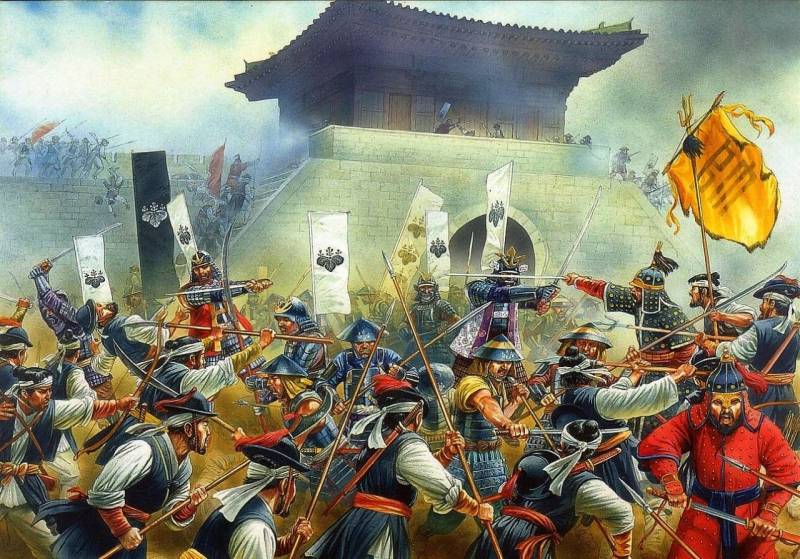
Japanese invasion 1592–1598 to Korea, known as the Imjin War, became one of the bloodiest and largest military conflicts of the XNUMXth century. Almost all the significant states of East Asia - China, Korea and Japan - were drawn into it. Hundreds of thousands of soldiers, sailors, partisans and militias took part in this armed confrontation, which took place on the Korean Peninsula and adjacent waters. In terms of scale, the Imjin War far exceeded the European wars of the XNUMXth century.
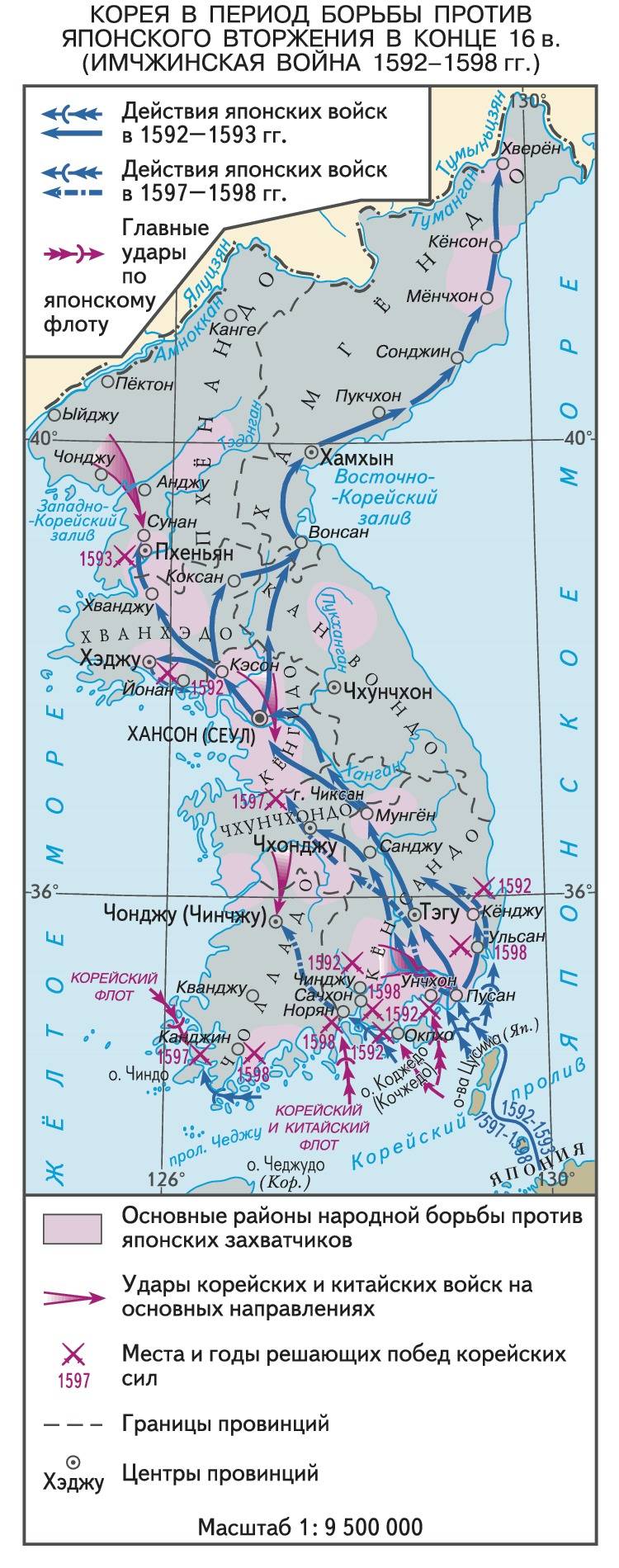
Korea during the Imjin War of 1592-1598
By the beginning of the 1590s. The talented and successful Japanese commander Toyotomi Hideyoshi, successfully using military and diplomatic methods, completed the unification of Japan under his rule. The local daimyo princes swore an oath of allegiance to the new master of the country, pledging to be his vassals, pay tribute and deploy military contingents in case of war. Hideyoshi, who made a dizzying career from a peasant to the de facto ruler of the country, was a very ambitious person and hatched truly grandiose plans. He set out to create a great East Asian empire, thereby anticipating the plans of the Japanese military and politicians in the 1930s. Under the command of Toyotomi Hideyoshi there was a large army, seasoned in battles and led by experienced commanders, which gave the newly-minted ruler of Japan self-confidence.
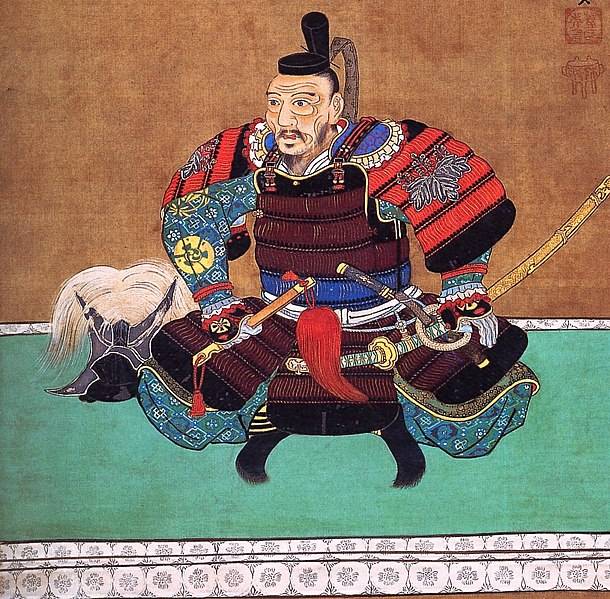
Toyotomi Hideyoshi
Hideyoshi's conquest plans stretched very far. His main goal was the conquest of China, which since 1368 was under the rule of the Ming Dynasty. Since the end of the XNUMXth century, this huge and powerful country has been in a deep internal political crisis. The ambitious Japanese ruler also planned to include Korea, the Philippines, which at that time belonged to the Spanish crown, and even distant India into his future empire.
The expansionist aspirations of Hideyoshi also had a very specific material reason. The unifier of Japan needed to enlist the support of his vassals, to force them to serve himself and his clan not out of fear, but out of conscience. With the onset of peaceful life in the Land of the Rising Sun, all the lands in it turned out to be distributed, and the military class was left idle. Having set the goal of creating a great Asian empire with the prospect of endowing his vassals with new lands, Hideyoshi could hope to win their loyalty and strengthen his power over the newly united country.
The first step towards the creation of a new empire was to be the conquest of Korea. At the end of the XNUMXth century, Korea, then called Joseon, was a small and peaceful state. The Japanese perceived it as easy prey and a springboard for the invasion of China. The Li dynasty, which ruled the country from the end of the XNUMXth century, was guided by China of the Ming dynasty, considering it as its protector and patron. Korea was considered a vassal of the Ming Empire, and the Korean kings (vans) regularly sent embassies with gifts to the Chinese Son of Heaven in Beijing. At the same time, China did not interfere in the internal affairs of the kingdom, and therefore one cannot speak of vassalage in the European sense of the word.
Unkind Neighbors
The first information about Korean-Japanese relations dates back to the first centuries of our era. At that time, the Korean Peninsula was divided into three kingdoms - Goguryeo, Baekje and Silla. In the south, in the lower reaches of the Naktong River in the XNUMXst-XNUMXth centuries. there was an alliance of Kaya tribes, known in Japanese sources as Mimana. According to nationalist Japanese historians of the late XNUMXth and early XNUMXth centuries, Kaya was either a tributary or a colony of the Yamato country, but there is no convincing evidence for this. Nevertheless, it is known that one of the ancient Korean states, Baekje, established close relations with Japan, and its last ruler even entered into a military alliance with the islanders.
Relations between the three kingdoms, as usual, were very far from fraternal, and as a result, the confrontation between them ended in the victory of Silla and the unification of most of the Korean Peninsula under his rule. In 663, in an effort to support the Baek rebels who fought against Silla and China, the Japanese, called the “people of the Wa country” in the then Chinese sources, sent a fleet to Korea, but were defeated. After the unification of Korean lands under the rule of the kingdom of Silla in 668, relations between the Koreans and their island neighbor began to be peaceful. Korea at that time served as a kind of cultural bridge between China and Japan. Buddhism, Confucianism, book printing, some types of crafts came to the Japanese islands through Korea.
However, over time, relations between the two neighbors began to deteriorate. In 1274 and 1281, Korea, which by that time had recognized the authority of the Mongol Yuan dynasty, became a springboard for the invasions of the armies of Kublai Khan on the Japanese islands. Ships were built in Korean shipyards to transport Mongol troops, and thousands of Korean soldiers took part in both invasions and died. In the XIV-XVI centuries. The coast of Korea was repeatedly raided by Japanese pirates. wako. Detachments of sea robbers not only plundered the coastal areas, but also penetrated 25–30 km deep into the mainland, capturing people into slavery and putting to fire and sword the settlements that stood in their way.
One of the main pirate nests was the island of Tsushima, located much closer to Korea than to Japan. Fighting the Japanese raids, the Koreans not only defended themselves, but also retaliated against the bases of the sea robbers. So, in 1389, the Korean commander Pak Wi attacked Tsushima and burned more than 300 pirate ships. In battles with Japanese pirates, the star of the commander Lee Song Ge, the future founder of the royal Lee dynasty (1392–1910), rose. The largest military operation of the Koreans against the Tsushima sea robbers took place in 1419, when a 17-strong army led by the commander Li Jongmu attacked Tsushima on 227 ships.
In fierce battles that lasted for three months, the pirates suffered significant damage, which allowed the Koreans to interpret this campaign as their victory. The ruler of Tsushima recognized symbolic vassalage in relation to Korea and promised to continue to prevent attacks from pirates. At the same time, a trade agreement concluded in 1443 with the authorities of the island allowed the Japanese to trade in the three southern ports of Korea.
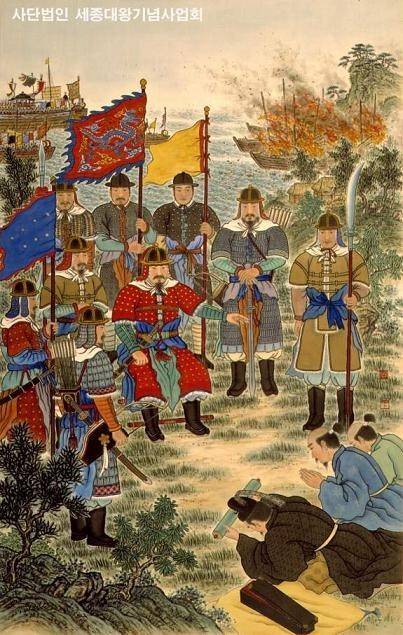
Korean Warlord Lee Jongmu Receives Pirate Envoys
In subsequent years, the activity of pirates in the coastal waters of Korea really began to decline, and trade relations between Korea and Japan developed dynamically. In the three ports open to trade and located on the site of the current cities of Busan, Ulsan and Chinhe, Japanese communities arose. Being exempted from paying duties, the Japanese were actively engaged in trade, agriculture and fishing.
However, they did not forget about their former, piracy habits, periodically attacking Korean ships. In 1510, in response to attempts by the Joseon authorities to limit such arbitrariness, the Japanese settlers raised an uprising, which was soon suppressed by government troops. Nevertheless, pirate raids on the Korean coast did not stop after that.
The path to war
The main goal of Hideyoshi's proposed campaign was China. The path to the Middle Empire by land lay through Korea, so the Japanese ruler was interested in subjugating it. Before resorting to military measures, Hideyoshi started with diplomacy.
In 1587, he wrote a letter to the Korean king Seonjo, in which he demanded to recognize Korea's vassal dependence on Japan and pay tribute. He instructed his vassal, the ruler of Tsushima, So Yoshishige, to convey this letter to its intended destination. It seemed that the head of the Seo clan, who maintained close contacts with the Korean authorities, was ideally suited to carry out such an assignment. The problem was that So Yoshishige did not share Hideyoshi's warlike aspirations, since Tsushima, due to its favorable geographical position, played the role of a transit territory through which Korean goods fell directly to the Japanese islands.
This trade was also a source of wealth for the So clan itself. The Tsushima daimyo tried to soften the harsh wording of the letter and instructed his representative, Yutani Yasuhiro, to hand it over to the Korean monarch. However, the royal court found Hideyoshi's demands unacceptable and refused. The situation was aggravated by the defiant behavior of Yutani himself, who allowed himself rude mockery of the Koreans. Enraged, Hideyoshi ordered the execution of Yutani and his entire family.
The offending head of the So clan was replaced in his post by his adopted son, So Yoshitoshi, who enjoyed the trust of Hideyoshi.
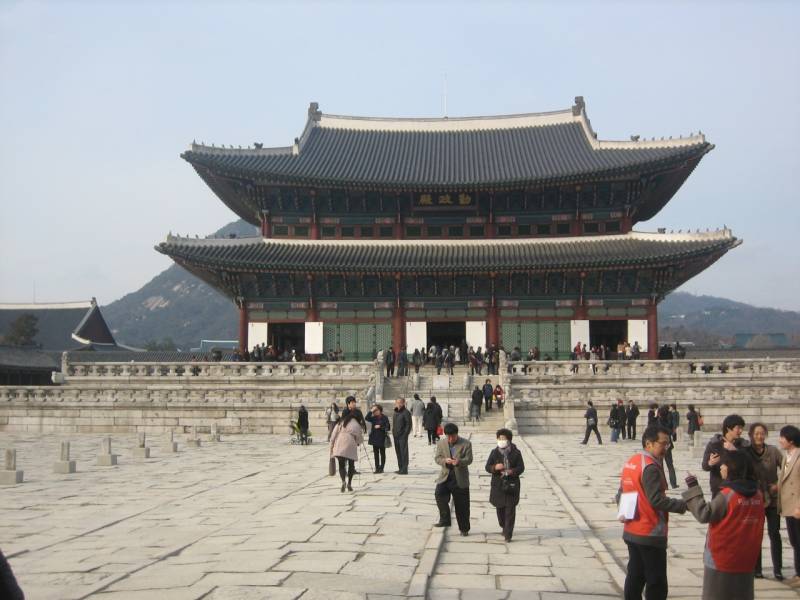
Gyeongbokgung is the royal palace of the Joseon period. Modern look. Author's photo
The envoy of the Tsushima ruler again went to Seoul. Without focusing on the aggressive intentions of the Japanese, he urged the Korean side to send an embassy to Japan. Finally, after much hesitation, the Korean royal court decided to send a diplomatic mission to the Japanese islands in order to ascertain Hideyoshi's intentions towards Korea. In 1590, the Korean embassy arrived in the city of Kyoto, the then capital of Japan.
At that time, there were two main political groups in the ruling elite of Korea - eastern and western. The Korean king (wang) was not an all-powerful monarch and had to take into account the balance of power at court when making political decisions. As a result, Hwang Jung-gil, a representative of the Westerners, was appointed head of the embassy, while Kim Sun-il, the Easterner, became his deputy.
Arriving in Kyoto, the Korean embassy was awarded an audience with Hideyoshi only after a three-month wait. The modesty of the official banquet, at which the guests were offered only rice cakes with sake, unpleasantly struck the Koreans, who attached great importance to official rituals. They conveyed to the Japanese ruler a message from King Songjo congratulating the unification of Japan and wishing to develop friendly relations between the two countries. Shortly after this reception, the Korean ambassadors left Kyoto.
Toyotomi Hideyoshi misinterpreted the arrival of a diplomatic mission as an expression of submissiveness on the part of the Korean ruler. In a response letter delivered by Korean ambassadors to Seoul, he praised the Korean wang for his decision to become a vassal of the Japanese emperor and, speaking of his intention to invade China, demanded that the Koreans let the Japanese troops pass through their territory. Considering the close relations of Korea with the Ming Empire, the Korean monarch could not respond to the demand of the Japanese ruler except with an unconditional refusal. War became inevitable.
Returning home, the head of the embassy and his deputy presented reports on their diplomatic mission to King Seongjo with diametrically opposed conclusions. If the "Westerner" Kim Sung-il claimed that Hideyoshi was preparing for an invasion, and war would soon begin, then the "Eastern" Hwang Yung-il did not see any threat from Japan. The opinions of other members of the embassy also differed.
As a result of the discussion of both reports, the royal court leaned towards the second point of view and did not begin large-scale military preparations. The only successful step taken by the Korean authorities on the eve of the war was the appointment of Yi Sun-sin as the commander of the Left fleet Jeolla province. Subsequently, this talented naval commander will play a huge role in repelling Japanese aggression.
In general, Korea was unprepared for the coming war.
The forces of the parties
For the invasion of Korea, the Japanese raised an army of 158, while another 800 warriors were placed as a reserve in the Nagoya castle area on the island of Kyushu. It was here that the headquarters of Toyotomi Hideyoshi was located. The invading army was divided into nine corps. The first to land in Korea were the corps under the command of Konishi Yukinaga (130 soldiers), Kato Kiyomasa (000 people) and Kuroda Nagamasa (18 people). They had to quickly capture the strategically important fortresses and ports and take Seoul, the capital of Korea, and thus clear the way for the rest of the army. Further, the troops were to move north, to the Yalu River (cor. Amnokkan), along which the border with China passed (today it passes there).
Further reinforced by Korean military contingents and having a supply base in Korea, the Japanese army was to invade China. If Hideyoshi entrusted the conquest of Korea to his subordinates, then he intended to lead the campaign against China personally. Looking ahead, we will say that during the years of the war he never set foot on Korean soil, because soon the campaign did not go the way the ambitious Japanese ruler had hoped.
The army of Toyotomi Hideyoshi was an impressive force and significantly surpassed the armies of future opponents - China and Korea in combat qualities. Most of the warriors were ashigaru foot soldiers recruited from among the peasants and fishermen. They were armed with spears, swords and bows and arrows. However, the most important weapons Japanese infantry had muskets. In 1543, Portuguese traders first brought arquebuses to the Japanese island of Tanegashima.
Soon the Japanese began mass production of firearms, and by that time ashigaru, armed with muskets, had become an integral part of the Japanese army. Of course, handguns of the XNUMXth century were very imperfect, since reloading a gun took a lot of time, and in terms of rate of fire it was inferior to a bow. However, the Japanese managed to solve this problem: during the battle, musketeers with already loaded guns stepped forward, while others retreated to reload theirs. In battle, the musketeers showered the enemy with lead bullets, leading to disorder in his ranks. Following them, infantrymen armed with spears and swords fell upon the enemy, completing the rout.
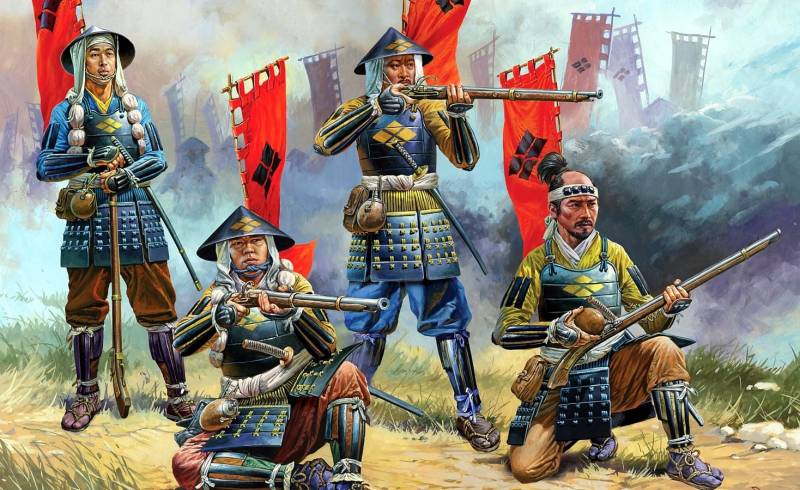
Ashigaru armed with firearms
At least half of the personnel of the infantry units were porters, cooks and other workers. They foraged, cooked food, set up camp, built fortifications. At the same time, each such worker owned a sword, a spear, or even could shoot a musket and thus was a completely full-fledged warrior.
The elite of the Japanese army were samurai. Samurai fought with a spear (yari) or naginata - a weapon consisting of a long shaft ending in a slightly curved blade. But the main weapon of the samurai warrior, reflecting his social status, was a katana - a long sword with a curved blade. Samurai warriors could fight the enemy both on horseback and on foot.
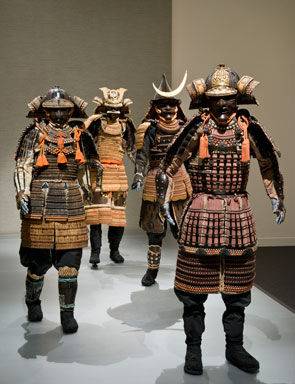
Samurai Armor
Undoubtedly, in terms of technical equipment, organization and individual military skill, the Japanese army was the best in East Asia at the turn of the XNUMXth-XNUMXth centuries. Nevertheless, one should not go to extremes and consider the superiority of the Japanese over their opponents as absolute.
Let's look at what the Korean army was like at that time. The basis of the Korean army was foot archers and spearmen. If on the battlefield the Japanese sought to get close to the enemy, then the Korean warriors tried to shoot the enemy with bows. Following this, the cavalry, armed with swords, halberds and flails, fell upon the enemy. It is important to note that Korean bows hit at a distance of 200 meters, which was twice the Japanese. In terms of equipment and quality of artillery, the Korean troops were far superior to the Japanese, and a number of interesting innovations were used directly during the war against the invaders, including rocket launchers, "chariots of fire", multiple rocket launchers, etc.
However, in general, the Korean armed forces were ill-prepared for a war with such a serious enemy as the Japanese. Most of the Korean army consisted of mobilized peasants who were unfamiliar with military affairs. Another important problem was the low quality of the command staff.
In Korean society, due to the privileged position of civil officials over the military, military service was not honored. The troops were commanded by military leaders-bureaucrats, many of whom at one time went into the army, having failed in passing exams for public office. Their knowledge of military affairs was often limited to familiarity with the classic treatises on the art of war, written in ancient Chinese.
In addition, for two centuries, Korea did not know major military conflicts. The Korean troops fought the Japanese pirates in the south with varying success and held back the raids of the Jurchen tribes on the northern and northwestern borders.
However, these hostilities were limited in nature and were not full-scale wars. At the same time, starting from 1467, Japan lived in a state of constant internecine wars. These military conflicts gave rise to many experienced warriors and military leaders, and almost the entire army of Hideyoshi consisted of professionals who had dozens, if not hundreds of battles behind them.
Of course, one cannot deny the advantage of the Japanese in armament. Unlike them, the Koreans were not armed with arquebus / muskets. The armament of the Korean warrior was quite modest and was limited to either a spear or a bow with arrows. Often, infantrymen did not even have protective armor. Some Western authors (for example, the famous samurai specialist Stephen Turnbull) claim that "Korean swords were short daggers," so it was difficult for Koreans to resist the samurai in hand-to-hand combat. In fact, Korean swords were only slightly inferior in length to Japanese ones and did not differ much from them in appearance. A much more important circumstance was the low level of training of Korean soldiers and their meager combat experience.
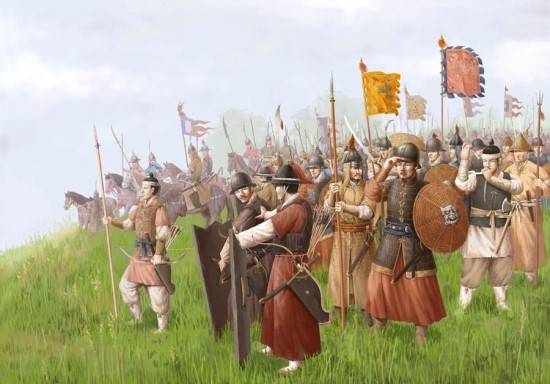
Korean warriors during the Imjin War
The peculiarities of command and control of the Korean armed forces were dictated not so much by military expediency as by political considerations. The army was divided into five corps stationed in various provinces of the country and included garrisons of fortresses and naval bases. A separate military group defended the capital of the country, Seoul.
The commanders who commanded the corps were all the time in Seoul and could go to their troops only in the event of an enemy invasion. Fearing a possible military coup or rebellion, the government tried to keep them under control. The military leaders who were far from their soldiers had a poor idea of the number, level of weapons and training of the units they were supposed to command in the event of a war.
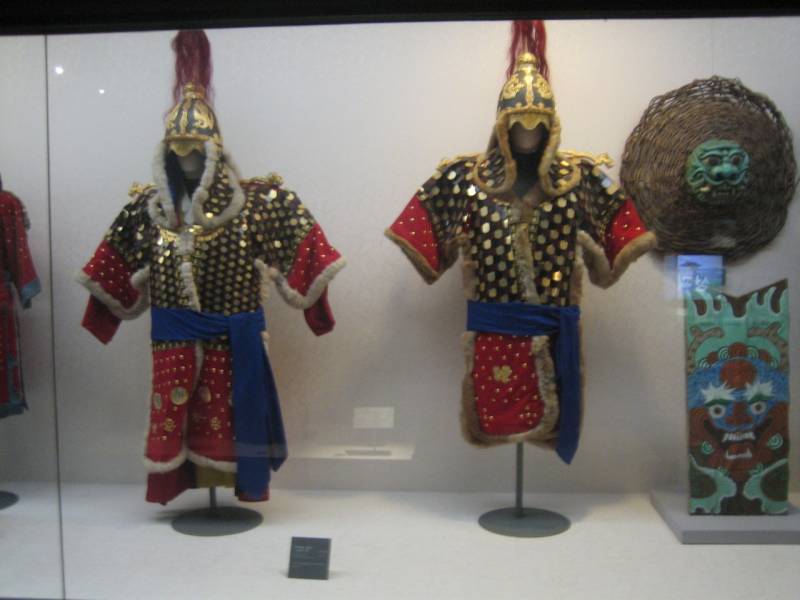
Armor of Korean commanders. War memorial of the Republic of Korea. Author's photo
The Korean army, which was recruited on the basis of universal conscription, was quite numerous on paper, but at the same time poorly armed and trained. In 1537, the practice of paying off military service was legalized, which led to the degradation of the Korean armed forces.
Thus, the Korean land army was not ready to repel Japanese aggression.
For the invasion, the Japanese assembled an impressive fleet of approximately 1 ships and 000 personnel. However, 9% of this armada were transport ships, while the actual warships had very few guns and were inferior to the Koreans in all respects. The Korean fleet had the opportunity to destroy the enemy at sea, but because of the mediocre and indecisive command, it did not dare to take active steps.
Shock and Awe
The invasion was planned for the spring of 1592. Since 1592 was marked in the 60-year cycle of the Korean calendar under the name imjin, in historiography the war was called Imjin.
On May 23, the Japanese armada, which had safely crossed the strait, appeared at Pusan, the largest seaport on the peninsula, and the next day troops began to land. The head of the Busan garrison, Chon Bal, refused the Japanese offer to surrender the city.
The corps of Konishi Yukinaga was the first to land on Korean soil. The Tsushima daimyo So Yoshitoshi, already familiar to us, being a subordinate of Konishi Yukinaga, attacked Busan at the head of a 5-strong detachment, while Konishi himself attacked the nearby Tadejin Fort with the main forces and soon captured it.
So Yoshitoshi's attack on Busan met with fierce resistance from his defenders. The Koreans showered the Japanese with a hail of arrows, but were swept away by the massive fire of the Japanese musketeers. Chong Bal himself fell in battle from an enemy bullet.
From the very beginning, the stay of the Japanese on Korean soil was marked by massacres. Intoxicated with bloodlust and angered by the short but fierce resistance of the enemy, the Japanese soldiers betrayed everything to fire and sword, mercilessly killing Korean men and women who tried to escape. According to the Japanese chronicle "Taikoki", the number of Koreans killed after the capture of the city was 8 people.
10 km north of Busan on the road leading to Seoul, there was a mountain fortress Dongne. The day after Pusan was taken, Konishi's troops surrounded her. The commandant of the fortress, Song Sanghyun, like Jung Bal, refused to let the Japanese through, answering them succinctly:
After a fierce assault, the fortress fell, and Son died a heroic death.
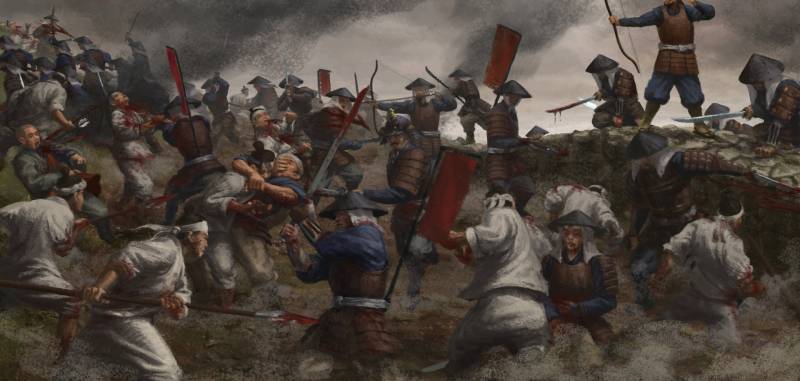
Painting by contemporary South Korean artist Jeong Jae-kyung, which depicts the assault on a Korean fortress by the Japanese during the Imjin War
A few days after the capture of Pusan, the corps of Kato Kiyomasa and Kuroda Nagamasa landed on Korean soil. They moved north, following Konishi. The Japanese were advancing swiftly, with little or no resistance.
Upon learning of the Japanese invasion, the royal court sent a hastily assembled military contingent under the command of the commander Xing Yip against the enemy. With an 8-strong army, the commander, instead of occupying a strategically important pass in the way of the Konishi corps, decided to fight on a plain near the city of Chungju (about 100 km from Seoul). Obviously, he counted on the high fighting qualities of the Korean cavalry.
The position chosen by Xing Yip for the battle turned out to be extremely unfortunate. From the north and from the west, the detachment rested against the river, and in the east - against the Tangumde hill. Thus, in case of defeat, the Korean warriors could not flee. Without justifying Xing Yip, it is worth noting that this commander, who became famous in the wars with the Jurchens, had considerable combat experience, and in order to make such an absurd decision at first glance, he must have had some reason. Probably, Sin Yip deliberately put his army in a hopeless situation in order to force him to fight not for life, but for death.
However, Xing clearly underestimated the enemy. During the battle, Japanese arrows from muskets and bows literally swept away the ranks of the Koreans. Sin Yip, at the head of the cavalry, made a desperate attack, but the Korean horsemen were mowed down by the fire of the Japanese musketeers. Sin Ipa's army succumbed to panic, and the Koreans began to seek salvation in flight. Not everyone managed to escape. Someone fell from a sword or spear, someone drowned in the river. Over 3 heads of Korean warriors were presented to Konishi after the battle. Several hundred Koreans were captured. Xing himself committed suicide by throwing himself into the river.
Thus, the first major field battle of this war proved the superiority of the Japanese in weapons and tactics.
When news of the catastrophe reached Seoul, panic seized the city. Frightened by the approach of the enemy, the inhabitants began to leave the city en masse. King Songjo with his court left the capital and went to Pyongyang, located much to the north. As soon as he left Seoul, the city was in the grip of chaos. Some of the townspeople began to rob the abandoned royal palaces, administrative buildings and houses. Soon fires began, quickly spreading to the royal palace. The dissatisfaction of the lower classes with the policies of the upper classes manifested itself, in particular, in the fact that during these riots the lists containing the names of slaves and their owners were burned.
Meanwhile, the corps of Konishi Yukinaga and Kato Kiyomasa were advancing on Seoul. Both commanders sought to be the first to enter the Korean capital. The rivalry between them was largely determined by the personal characteristics of the commanders. Kato and Konishi were completely different people. 34-year-old Konishi Yukinaga, a daimyō from Kyushu, was a Catholic. At that time, many Japanese daimyo on the island of Kyushu converted to Christianity as a result of the preaching of the Jesuits.
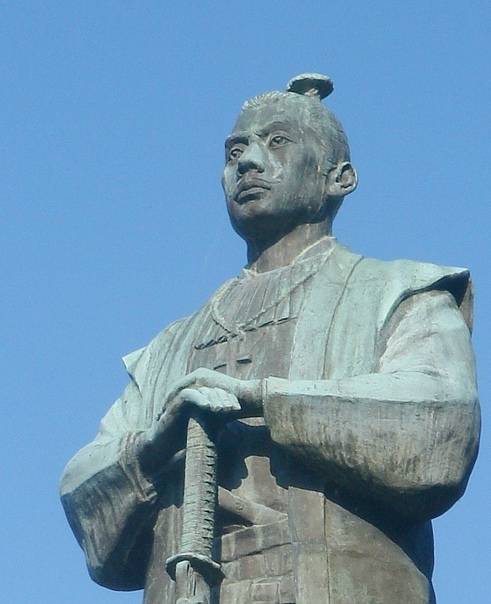
Statue of Konishi Yukinaga
Not surprisingly, most of Konishi's vassals and a large part of his host were newly converted Christians. 30-year-old Kato Kiyomasa, on the contrary, was a zealous Buddhist and adhered to the teachings of the well-known Buddhist school Nichiren in Japan. He was distrustful of the "southern barbarians" the Japanese called the Portuguese, and viewed Christian daimyo like Konishi with suspicion. There is nothing surprising in the fact that all the warriors of Kato were zealous Buddhists, like their commander. If Konishi Yukinaga was a refined nature, who had an interest in art, then Kato Kiyomasa was a rough and furious warrior.
It is not surprising that two such different people could not stand each other, and their rivalry left its mark on the further course of events.
Corps Kato and Konishi rushed to Seoul. The Korean capital was protected from the south by the wide Han River. The Kato troops ran into the river, and all the boats in the vicinity were destroyed in advance by the Koreans in order to slow down the advance of the invaders. While Kato Kiyomasa was losing time, Konishi Yukinaga's warriors, who approached the city from the east side, quickly prepared rafts for the crossing. A small Korean detachment, called upon to cover the approaches to the capital, fled, and on the morning of June 12, Konishi Yukinaga's soldiers entered Seoul.
Thus, Konishi was ahead of his unlucky rival, if only by a few hours. A few days later, the troops of Kuroda Nagamasa entered the city. In other words, already 20 days after the landing, the Japanese were able to capture the Korean capital.
March north
Continuing their offensive to the north, the Japanese troops reached the Imjingan River. On the other side, there was a newly assembled 12-strong Korean army under the command of Kim Myeongwon, and all the boats were destroyed in advance by the Koreans. Despite the almost twofold superiority of the Japanese in manpower, the Korean army occupied an ideal defensive position and held back the Japanese for ten days, preventing them from crossing to the other side. But the lack of unity of command ruined the Koreans. Kim Myeongwon was not a sovereign commander-in-chief - part of the army was commanded by the courtier Han Uning.
On July 7, 1592, the Japanese began a feigned retreat. Encouraged by this sight, the young and hot-headed Korean commander Sin Khal ordered his soldiers to get into boats and cross to the other side. The more experienced commander Yu Gykryan, suspecting a trap, tried to dissuade him, but in response he was accused of cowardice. Khan Uning supported Sin and ordered his soldiers to join him. Kim Myeong-won considered the attack a bad idea, but due to the lack of complete control over the army, he could not do anything and joined her. Korean soldiers crossed to the other side of the river. The Japanese continued to retreat without offering resistance.
Pursuing them, the Koreans pushed deeper into the wooded area south of the river. Here they unexpectedly came under heavy fire from Japanese musketeers. Very soon the battle turned into a beating of the Korean army. 10 Korean warriors were killed or drowned in the river, while Japanese losses were minimal.
After forcing the Imjingan River, the Japanese offensive continued in two directions. Corps Konishi Yukinaga moved to the northwest, in the direction of Pyongyang. His rival Kato Kiyomasa was moving through the territory of the province of Hamgyongdo in northeast Korea. Kuroda Nagamasa with his warriors supported the advance of Konishi.
The Japanese approached Pyongyang without hindrance. King Seonjo left the city and moved to Uiju, near the border with China. Pyongyang was a well-fortified fortress with a garrison of 10. The Korean commanders Kim Myung Won and Lee Il decided to conduct a night attack on the Konishi camp in order to inflict as many losses as possible on the enemy. However, the crossing of the Korean warriors in boats across the Taedongan River, which separated the city from the Japanese camp, was delayed, and they ended up on the other side just before dawn. At first, the attack developed successfully, several hundred warriors in Konishi Yukinaga's camp were killed. However, the Japanese quickly came to their senses, the troops of Kuroda Nagamasa arrived in time to help Konishi and drove the attackers back.
Upon learning of the defeat, the Korean command fled the city. Following him, thousands of residents of Pyongyang rushed. Encountering no resistance, Konishi Yukinaga's troops occupied the second largest city in Korea.
At this time, the corps of Kato Kiyomasa conquered the province of Hamgyondo. Operating in mountainous and often wild terrain, where roads were often absent, Kato's troops advanced successfully. Under Hejyongchang, the corps of Kato Kiyomasa encountered a large Korean army. The battle turned out to be long and fierce, as the Koreans acted smarter and more decisively than usual. After suffering heavy losses, the Japanese retreated to the rice storage. They took cover behind barricades made from sacks of rice. The Koreans boldly attacked the enemy, but the massive fire of the Japanese musketeers forced them to retreat.
The Korean commander Han Kukham thought to resume the battle the next day, but Kato Kiyomasa beat him to it. At night, the Japanese secretly approached the Korean positions, surrounded them and opened fire at dawn. The Koreans fled in panic, but the Japanese were everywhere. There was only one road that was not blocked by them, and the fleeing Koreans rushed along it. However, this was a trap prepared by Kato, since this road led to a swamp. The Korean soldiers were killed, the commander Han escaped, but a few days later he was handed over to the Japanese by his own compatriots and thus ended up in Japanese captivity.
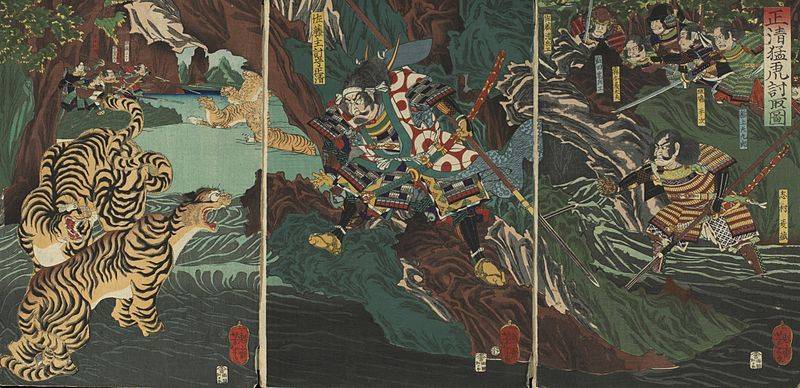
Kato Kiyomasa hunts tigers in the mountains of Korea
It is interesting to note that it was in the province of Hamgyongdo that mass cooperation between local authorities and a significant part of the population with the occupiers became widespread. The fact is that Seoul officials disdainfully looked at this region remote from the capital. Its inhabitants were considered untrustworthy, heavily taxed and discriminated against. This led to the fact that in the conditions of the collapse of state power and military defeats, not the entire population of Hamgyondo was ready to fight with weapons in their hands against the Japanese.
The Korean princes Sunhwa and Imhae were in the city of Hweryeong on the border with China. The city served as a place of exile for those individuals whom the government considered politically unreliable. It is not surprising that anti-government sentiments are especially prevalent in this place. One of the local officials ordered the arrest of the princes, and when Kato Kiyomasa arrived in the city, he saw the kneeling princes, bound like criminals. Kato ordered to untie them and treat them according to their origin. During the war, Sunhwa and Imhe were held by the Japanese in the position of especially valuable hostages. The official who seized them expressed a desire to cooperate with the occupiers and was appointed governor of the province by them.
When Kato approached the Tumangan River, which separated Korea from the lands inhabited by the Jurchens (Manchuria), 3 Korean soldiers joined him. The fact is that the Jurchens repeatedly raided the border areas of Korea, and the Koreans experienced a completely understandable desire to get even with their old enemies, even if they acted in concert with the samurai invaders. Having crossed the river, the Kato warriors soon came across a small Jurchen fortress and took it by storm, killing its defenders. After that, the Korean soldiers left the Japanese and returned back.
The Japanese were forced to take the blow of the enraged Jurchens, who sought to avenge the attack on the fortress. The Kato warriors suffered losses, and only a sudden downpour forced the Jurchens to stop their attacks and allowed the Japanese to break away from the persecution and retreat to Korean territory.
Thus, Kato Kiyomasa's raid into Manchuria became the only armed clash of the Imjin War that took place outside the Korean Peninsula.
By the autumn of 1592, the Korean ground forces were defeated, the main centers of the country, such as Seoul and Pyongyang, were captured, the king fled far north to the Chinese border.
What were the reasons for such impressive Japanese victories at the initial stage of the war?
South Korean historians attribute the rapid advance of the Japanese and their impressive successes to the mass equipment of Japanese soldiers with handguns. Indeed, there were no units of arquebusiers or musketeers in the Korean army. Of course, we can talk about the qualitative superiority of the Japanese in weapons, but their main advantage was different. Almost all participants in the invasion had solid military experience. Behind the shoulders of the samurai warrior there were many large and small battles, sieges, duels. In terms of combat experience and individual military training, Korean warriors could not compete with the samurai, and therefore suffered defeat in clashes with them.
Another important reason was Korea's general unpreparedness for war. Due to factional struggles at the top, no effective measures were taken in case of a possible invasion. By the time King Seonjo realized the reality of the threat of invasion, preparation time had already been lost, and once the invasion began, the Korean authorities failed to mobilize troops quickly and effectively. As a result, the Korean troops were fragmented into scattered garrisons and detachments and were relatively easily destroyed.
In addition, it must be borne in mind that historically Korea suffered from invasions from the north, so the bulk of the troops and defensive structures were concentrated north of Seoul. The southern part of the peninsula was not ready to repel a large-scale invasion. In particular, Seoul fell just 20 days after the landing of Japanese troops in Pusan, while the Japanese army's journey from Seoul to the Chinese border took two and a half months.
Toyotomi Hideyoshi had every reason to rejoice. He was already making ambitious plans. Hideyoshi planned to invade China and install the Japanese emperor in Beijing. As the ruler of Korea, he wanted to appoint his nephew Hidetsugu or Ukita Hideie, who he had appointed commander-in-chief of Japanese troops in that country. Hideyoshi himself intended to settle in the Chinese port city of Ningbo and manage his empire from there.
However, the events that followed abruptly changed the course of the war and forced the Japanese ruler to adjust his plans...
Продолжение следует ...
Information